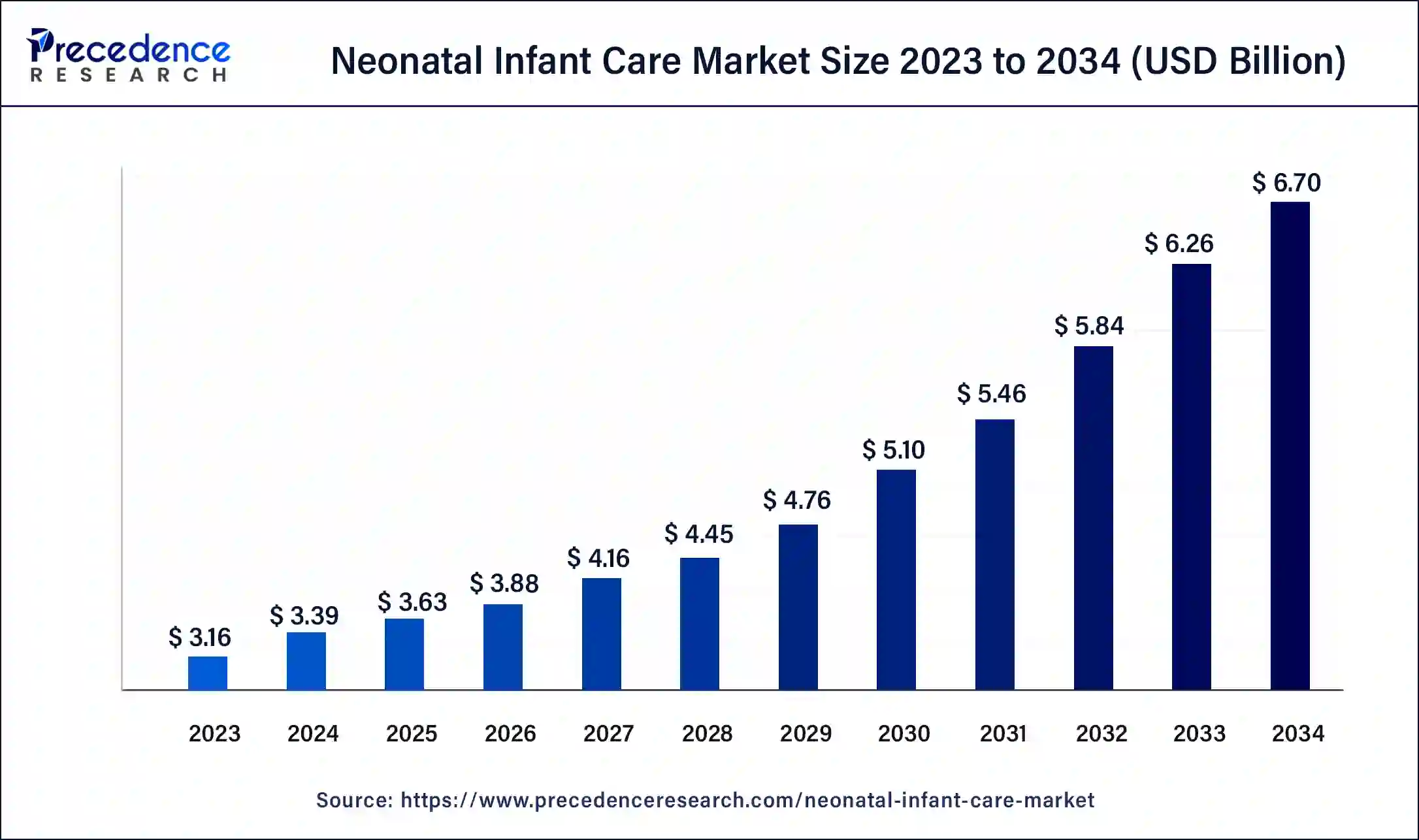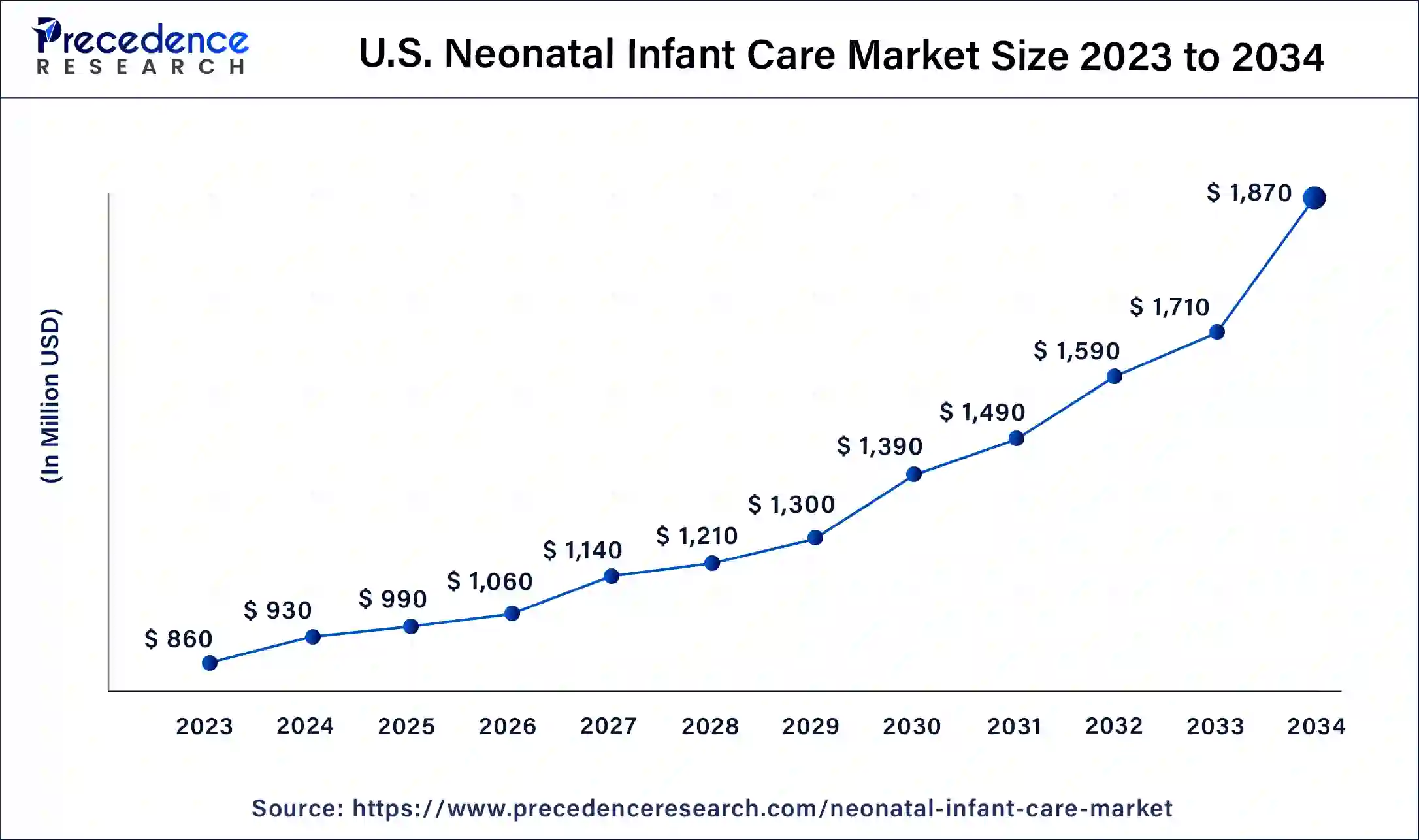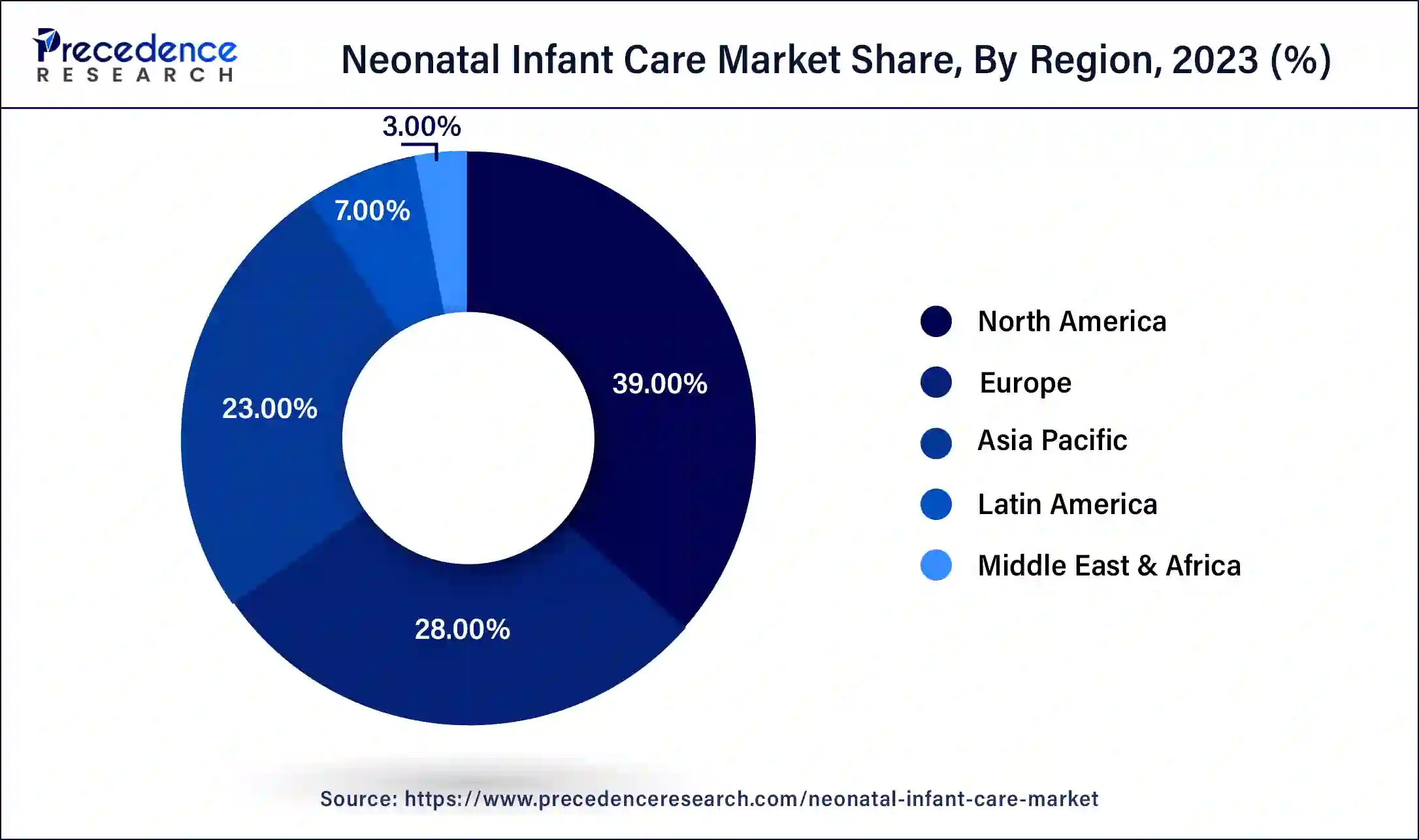September 2024
The global neonatal infant care market size was USD 3.16 billion in 2023, calculated at USD 3.39 billion in 2024 and is expected to be worth around USD 6.70 billion by 2034. The market is slated to expand at 7.04% CAGR from 2024 to 2034
The global neonatal infant care market size is worth around USD 3.39 billion in 2024 and is anticipated to reach around USD 6.70 billion by 2034, growing at a CAGR of 7.04% over the forecast period 2024 to 2034. The North America neonatal infant care market size reached USD 1.23 billion in 2023. The neonatal infant care market is driven as premature babies frequently need specialized care, there is a greater need for neonatal infant care goods and services. Improving mother and child health, especially newborn care, is a priority for governments and healthcare institutions.

The global U.S. neonatal infant care market market size was exhibited at USD 860 million in 2023 and is anticipated to reach around USD 1,870 million by 2034, growing at a CAGR of 7.31% over the forecast period 2024 to 2034.

North America dominated in the neonatal infant care market in 2023. Neonatal care is covered by health insurance for a sizable section of the population in the United States. Families will pay less because of this accessibility, guaranteeing that newborns receive timely and sufficient medical care. In North America, public health initiatives and education are highly prioritized to increase awareness regarding the significance of prenatal and neonatal care. The need for neonatal care goods and services is fueled by this awareness, which leads to earlier treatments and improved care for newborns.

Asia-Pacific is observed to be the fastest growing in the neonatal infant care market during the forecast period. The area is rapidly implementing cutting-edge technologies for neonatal care. New developments in respiratory equipment, incubators, and neonatal monitoring are being adopted, raising the bar for care. In addition to government initiatives, the private healthcare industry in the area is increasing. Modern neonatal care units are purchased by private hospitals, which fuels the market's expansion. Throughout the region, training programs on newborn care are being launched and expanded for healthcare personnel. This raises the standard of care and encourages the use of cutting-edge newborn technologies.
The term neonatal infant care describes the worldwide market for goods and services specially made to monitor, care for, and treat newborns, especially those who are prematurely born or have medical issues that call for specialist attention. Products in this market include newborn monitoring devices, incubators, ventilators, phototherapy equipment, and related consumables. The demand for improved newborn care facilities and equipment is driven by growing healthcare expenses and increased awareness of neonatal health, especially in developing nations such as India. This sector enhances public health since proper newborn care lowers infant mortality and prevents long-term health problems.
How is AI helping the neonatal infant care market growth?
Employing EEG data to automatically identify neonatal sleep stages, artificial intelligence (AI) has been extensively studied in sleep studies of both term and preterm infants. The ability to identify different sleep stages may potentially improve neuroprotective treatment, since fewer disruptions during deep sleep may be beneficial. Preclinical research is now being conducted on AI-driven instruments for assessing neonatal cortical background activity. Another crucial function of EEG monitoring is the identification of paroxysmal episodes. Seizures are the most common neurological emergency in the neonatal population, and they carry the highest chance of occurring at any point in life. In neonates, seizures are thought to occur about 8% of the time.
| Report Coverage | Details |
| Market Size by 2034 | USD 6.70 Billion |
| Market Size in 2023 | USD 3.16 Billion |
| Market Size in 2024 | USD 3.39 Billion |
| Market Growth Rate from 2024 to 2034 | CAGR of 7.04% |
| Largest Market | North America |
| Base Year | 2023 |
| Forecast Period | 2024 to 2034 |
| Segments Covered | Product Type, End-Use, and Regions |
| Regions Covered | North America, Europe, Asia-Pacific, Latin America and Middle East & Africa |
Higher birth rates combined with improving healthcare infrastructure
An increasing number of babies means a growing market for goods and services created especially for newborn care. This covers many goods, from infant food and diapers to more advanced items, including breathing support systems, thermoregulation equipment, and neonatal monitoring devices. Enhancing healthcare architecture also highlights the caliber of care given to infants. Better facilities and equipment enable healthcare providers to deliver more thorough and efficient neonatal care, improving outcomes and increasing demand for premium goods.
Table: Spending on healthcare in various countries
| Countries | Expenditures |
| United States | $4.5 trillion |
| Australia | $132 billion |
| Norway | $7 billion |
Limited access to advanced care
Even when central hospitals offer modern care, those living in remote or rural locations may be unable to access it due to a lack of dependable transportation. This disparity further limits the newborn care market by restricting the pool of possible clients to urban areas. Adoption of modern neonatal technology may be hampered in some areas by inconsistent and unsupportive regulatory frameworks. Regulatory obstacles can impede market expansion. Examples include strict import laws or lengthy approval processes for new technology. Health emergencies such as pandemics or natural disasters can burden the already scarce healthcare resources, taking money and focus away from newborn care. This brief or protracted emphasis change may slow the adoption of cutting-edge neonatal care solutions.
Progress in genomics and personalized medicine
Treatments can be customized to meet each neonate's unique needs using comprehensive genetic information. This includes tailored medication regimens or targeted therapies that will probably be successful given the infant's genetic profile. New technologies that use genetic data are being created to improve diagnosis speed and accuracy. To prevent growing health disparities, efforts must be made to guarantee that genomics and customized medicine innovations are available to all families, regardless of socioeconomic background. Healthcare providers and businesses can stand out from the competition by using cutting-edge genomic and customized medical techniques, drawing in more business and improving their reputation.
The thermoregulation devices segment dominated the neonatal infant care market in 2023. Due to their immature thermoregulatory systems, newborns, especially those born prematurely, are more vulnerable to hypo or hyperthermia. Maintaining an ideal body temperature is essential for their life and general well-being. Respiratory discomfort, metabolic acidosis, and even death can result from hypothermia. For this reason, trustworthy thermoregulation equipment is essential in neonatal care environments. It is expected to find sophisticated neonatal care equipment, such as thermoregulation devices, in areas with modern healthcare infrastructures.
In contrast, the market for thermoregulation equipment is expanding in emerging nations due to rising healthcare costs and the establishment of neonatal care units. The need for these devices is anticipated to increase as these regions' healthcare systems change.
The hospitals segment dominated the neonatal infant care market in 2023. Regarding newborn care, hospitals are frequently at the forefront of implementing new technologies. Improving baby survival and recovery entails utilizing cutting-edge monitoring technologies, noninvasive ventilation techniques, and upgraded incubators. Numerous governments prioritize the health of mothers and their children, which results in significant investments in hospital-based newborn care facilities. These covers providing money for NICU growth, educating medical staff, and guaranteeing patients access to necessary medical supplies. Hospitals must follow strict regulatory requirements and accreditation procedures to ensure that neonatal care achieves high standards for quality and safety. Patients' and healthcare professionals' continued trust depends on this compliance.
The nursing homes segment is observed to be the fastest growing in the neonatal infant care market during the forecast period. More people are living longer because of advancements in healthcare, but these longer lives are frequently accompanied by chronic illnesses or impairments that call for continuous care. These demands are satisfied by the complete care environments offered by nursing homes. Families are commonly scattered around cities due to rapid urbanization, especially in emerging nations, which makes it challenging to care for aging relatives at home.
Nursing homes provide a workable alternative for families that cannot give the required care. In the US, the economics of nursing facilities are heavily influenced by Medicare reimbursements. The financial stability of nursing homes increases due to these programs' ongoing expansion of long-term care coverage, which promotes more investment and industry expansion.
By Product Type
By End-use
By Geography
For inquiries regarding discounts, bulk purchases, or customization requests, please contact us at sales@precedenceresearch.com
No cookie-cutter, only authentic analysis – take the 1st step to become a Precedence Research client
September 2024
March 2025
February 2025
January 2025